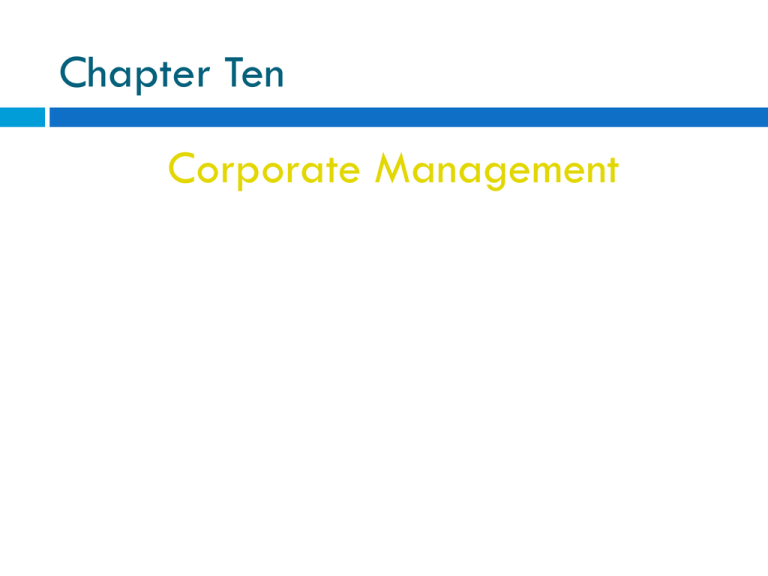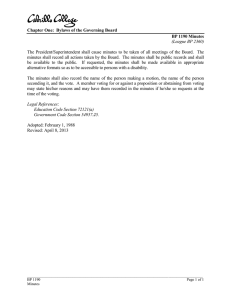Chapter Ten Corporate Management
advertisement

Chapter Ten Corporate Management Shareholders’ Rights and Responsibilities Shareholder: An owner of a corporation; also called stockholder Voting Rights Straight voting: voting in which each share of record has one vote (also called statutory voting) Cumulative voting: method of voting in election for directors in which each share carries as many votes as there are directors being elected Class voting: voting by a class of stock as a separate unit. Contingent voting: voting rights that exist only upon the occurrence of some event. Disproportionate voting: voting rights held by a class that is disproportionate to voting rights of other classes Nonvoting stock: stock that carries no voting Directors Directors are those who manage a corporation Piercing the Veil Holding individual shareholders liable for corporate obligations Three most frequent examples of conduct that leads to piercing of the veil: Commingling of Assets Lack of Formalities Inadequate Capitalization Suspected Causes of Corporate Scandals Excessive compensation Expensing of stock options Board conflicts of interest Lack of accounting oversight Euphoria and hype Lack of regulatory oversight Greed Provisions of the American Recovery and Reinvestment Act of 2009 Some of the provisions in the American Recovery and Reinvestment Act of 2009 (the Obama administration’s ‘‘stimulus bill’’) include the following measures, aimed at promoting the long-term health of American companies: Pay caps on senior officers of companies that receive massive government assistance. Compensation provisions that restrict additional compensation to executives to the form of stock that can only be redeemed by the executives after federal bailout money is repaid. Provisions allowing shareholders whose companies have received federal bailout funds to provide advisory votes on executive compensation, namely, ‘‘say on pay’’ votes. Provisions allowing the government to review bonuses and compensation paid to senior executives at companies who received federal bailout money to determine whether such payments should be recaptured or clawed back. Titles of Officers President Vice President Secretary Treasurer Other officers Chief executive officer (CEO) Chairman Chief financial officer Key Features of Corporate Management Corporations involve three groups of people: shareholders, directors, and officers. Although shareholders own the corporation, they do not manage it, and their participation primarily takes the form of voting to elect (or remove) directors and extraordinary actions. There are two types of shareholder meetings: annual meetings and special meetings. Slide 1 of 4 Key Features of Corporate Management Shareholders often vote by proxy. Shareholders may enter into agreements to pool their votes or otherwise concentrate their voting power. Shareholders may initiate action against the corporation; direct actions allege direct harm to a shareholder while derivative actions allege the corporation has sustained harm and has failed to enforce its own cause of action. Slide 2 of 4 Key Features of Corporate Management Although shareholders ordinarily have no liability for corporate obligations, they may be liable if they disregard the corporate entity by commingling assets, failing to observe corporate formalities, or undercapitalizing the corporation. Directors manage the corporation and are elected by shareholders; they meet in regular meetings or special meetings. Directors and shareholders may act without a formal meeting if they unanimously consent in writing to take action. Slide 3 of 4 Key Features of Corporate Management Directors have fiduciary duties to their corporation but will usually be protected from liability under the business judgment rule so long as there is some reasonable business purpose for their actions, and they did not act illegally or with gross negligence. Slide 4 of 4






